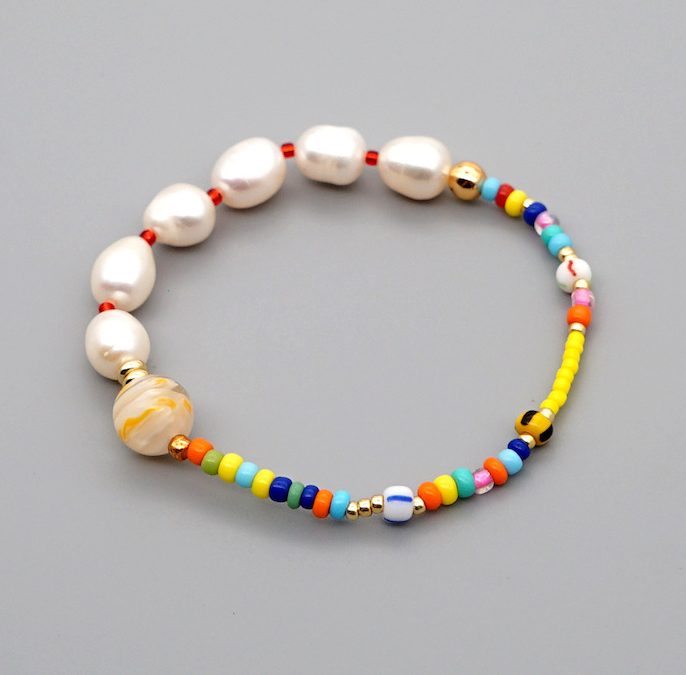Whenever you mention for “handmade”, it is hard to control all quality to be the same as it will be made by different labors….Handmade jewelry isn’t just an accessory—it’s a story, a piece of wearable art. But behind every stunning bracelet, ring, or pair of earrings lies a meticulous quality control (QC) process that ensures beauty meets durability. If you’re sourcing from a handmade jewelry manufacturer in China, mastering QC is your golden ticket to flawless products and happy customers.
This isn’t just another dry guide. We’re pulling back the curtain on how the best jewelers in China maintain impeccable standards—so you can deliver luxury without compromise.

tila tubular beads handmade jewelry necklace wholesales from china jewellery factory
Why Quality Control Can Make or Break Your Jewelry Business
Imagine this: A customer excitedly opens their package, only to find a clasp that breaks on first wear, a gemstone that’s loose, or a silver ring that tarnishes in days. One bad experience, and they’ll never trust your brand again.
That’s why QC isn’t optional—it’s survival. Here’s what’s at stake:
-
Customer Trust – One defect can lead to returns, refunds, and brutal online reviews.
-
Brand Reputation – In the age of social media, word spreads fast—especially about bad quality.
-
Legal Risks – Non-compliant materials (like nickel-heavy alloys) can trigger lawsuits.
Bottom line? Great QC = Happy Customers = More Sales.
Step 1: Choosing the Right Handmade Jewelry Manufacturer (The Make-or-Break Decision)
Not all factories are created equal. Some cut corners; others obsess over perfection. Here’s how to find the best of the best:
🔍 The Factory Audit Checklist
-
Certifications Matter – ISO 9001 (quality management) and RJC (Responsible Jewellery Council) are green flags.
-
Ask for Samples – A reputable handmade jewelry manufacturer will send prototypes before bulk production.
-
Visit in Person (or Hire an Auditor) – Surprise inspections reveal the truth about working conditions and craftsmanship.
📝 The Power of Clear Specs
Ever played the game “Telephone”? If your design brief gets lost in translation, the final product will too. Avoid disasters by:
-
Providing CAD designs with exact measurements.
-
Specifying material grades (e.g., 925 silver vs. cheap alloys).
-
Including reference photos of finishes (matte, polished, oxidized).
Step 2: The 4-Stage QC Process (How the Pros Do It)
Top manufacturers don’t just check quality at the end—they embed it into every step.
🔬 Stage 1: Raw Material Inspection
-
Metal Testing – XRF guns verify silver/gold purity.
-
Gemstone Verification – UV lights detect fake diamonds; microscopes check for inclusions.
-
Supplier Vetting – Only work with ethically sourced stones and metals.
✋ Stage 2: In-Process Checks (Where Most Mistakes Are Caught)
-
Soldering & Stone Setting – Are prongs secure? Is the weld smooth?
-
Polishing & Plating – No scratches, uneven coatings, or discoloration.
-
Dimensional Accuracy – Laser measuring tools ensure every piece matches the design.
✅ Stage 3: Final Inspection (The Last Line of Defense)
-
AQL Sampling – Inspect a percentage of each batch (e.g., 200 pieces out of 5,000).
-
Functionality Tests – Do clasps open smoothly? Do earring backs stay secure?
-
Packaging Check – Is each piece protected from scratches and tarnish?
📦 Stage 4: Pre-Shipment Verification
-
Third-Party Inspectors – Companies like SGS or Bureau Veritas provide unbiased reports.
-
Random Weight Checks – Ensures no underweight gold or silver pieces.
Step 3: High-Tech QC Tools (Because Eyeballing Isn’t Enough)
Gone are the days of relying solely on a jeweler’s loupe. Today’s best handmade jewelry manufacturers use:
-
3D Scanners – Compare finished pieces against digital models for precision.
-
Spectrometers – Instantly detect fake metals or gemstones.
-
Blockchain Tracking – Prove your gems are conflict-free with digital ledgers.
Step 4: The Feedback Loop (How to Keep Improving)
Great QC isn’t a one-time thing—it’s a cycle.
-
Track Defects – If 10% of rings have loose stones, the setting process needs fixing.
-
Supplier Scorecards – Rate your manufacturer on defects, delays, and communication.
-
Customer Returns Analysis – Are people complaining about the same issue? Address it at the source.

tila tubular beads handmade jewelry pearl bracelet wholesales from china jewellery factory
Real-World QC Horror Story (And How It Was Fixed)
The Problem: A boutique brand ordered 1,000 handmade silver necklaces—only to find 30% had broken chains upon arrival.
The Root Cause: The factory used subpar jump rings to save costs.
The Fix:
-
Rejected the entire batch and demanded a remake.
-
Updated the contract to require stress-testing on all chain links.
-
Switched to a more reliable supplier with a track record of durability.
The Lesson: Never assume. Always test.
Ethical QC: Beyond Just Quality
Today’s customers care about sustainability and ethics as much as shine.
-
Recycled Metals – More brands demand eco-friendly gold and silver.
-
Fair Wages – Audit factories to ensure artisans are paid fairly.
-
Conflict-Free Gems – Certify your stones with Kimberley Process compliance.
Final Tip: Never Skip the Contract
A handshake deal won’t protect you. Your manufacturing agreement should include:
-
Defect Penalties (e.g., 5% refund for every flawed batch).
-
IP Protection (so your designs aren’t copied).
-
QC Standards (clearly defined AQL levels).





